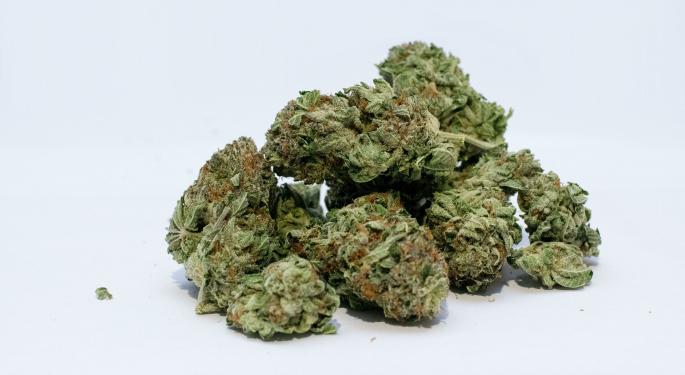When 2018 finally comes to a close, investors will likely look back and declare this the most game-changing year in cannabis history.
The big news, as you’re probably aware, was the legalization of recreational marijuana in Canada a little more than five weeks ago. When the industry is running on all cylinders, it’s expected to bring in billions of dollars in added annual sales, as well as generate plenty of green for the industry.
But beyond just Canada legalizing adult-use weed, it was a record-breaking year. We witnessed the first cannabinoid-based drug approved by the U.S. Food and Drug Administration, saw multiple U.S. states vote in favor of their marijuana initiatives in midterm elections, observed Tilray become the first Canadian pot stock to IPO on a reputable U.S. exchange, and had more than a half-dozen of the largest marijuana deals in history announced.
Aurora Cannabis has been a busy bee in 2018
What’s particularly interesting about this last point is that the two largest acquisitions in historybelong to Aurora Cannabis (NYSE:ACB), the projected leader in annual output.
You could rightly say it’s been a busy year for Aurora. Having begun the year with the expectation of just over 100,000 kilograms of annual production from its flagship Aurora Sky facility, along with Aurora Vie and Aurora Mountain, the company now forecasts around 570,000 kilograms of cannabis a year following its MedReleaf acquisition. Here’s a quick, but perhaps not all-inclusive, rundown of its capacity-expansion actions in 2018:
- Aurora acquired Saskatchewan-based CanniMed Therapeutics for $852 million in what is now the second-largest acquisition and third-largest deal of all time.
- It also acquired Ontario-based MedReleaf for $2.5 billion in July, marking the largest acquisition in cannabis history, and adding 140,000 kilograms of peak production.
- It announced the construction of a 1.2-million-square-foot facility in Medicine Hat, Alberta, to be known as Aurora Sun. When fully operational, it could yield 150,000 kilograms a year.
- Aurora announced a partnership with Alfred Pedersen & Son in Denmark to retrofit existing vegetable-growing facilities spanning 1 million square feet. Known as Aurora Nordic, this project could yield 120,000 kilograms per year.
Add this up, along with the company’s projects that were already in the works, and we arrive at the expected 570,000 kilograms of annual yield when it closed the MedReleaf deal.
Could Aurora top 1 million kilograms of annual production? Maybe…
Then, in September, Aurora Cannabis went shopping once again. It announced the acquisition of South America-based ICC Labs (NASDAQOTH:ICCLF) for just over $221 million. Although it’s not a huge deal, ICC Labs has a lot of capacity expansion and acreage at its disposal.
According to the press release describing the combination, ICC Labs has two operational greenhouses spanning an aggregate 92,000 square feet, along with two facilities that are under construction totaling 124,000 square feet and 1 million square feet, respectively. Since Aurora owns Larssen, a leading construction and consulting firm for greenhouses, it’ll be able to internalize its costs to get these facilities up to speed, and should be able to improve output.
It’s also noted that ICC Labs has three outdoor grow sites that could span more than 800 aggregate acres. Should Aurora choose to take advantage of this capacity, its ICC Labs acquisition could add an estimated 450,000 kilograms in annual production. Assuming the company is able to meet or exceed expectations with Aurora Sky, Aurora Nordic, Aurora Sun, and MedReleaf’s Exeter facility, it may be able to hit 1 million kilograms in annual output with ICC’s properties. Not to mention that there’s land adjacent to MedReleaf’s Exeter facility (94 acres) that could easily house a 1.5-million-square-foot facility capable of perhaps 175,000 kilograms of annual yield.
In other words, Aurora has a real shot to become the first pot stock to yield 1 million kilos of weed per year.
Production isn’t everything
However, investors should understand that production isn’t everything when it comes to marijuana stocks. It’s simply one piece of a very big puzzle.
With regard to Aurora Cannabis, investors would be implored to pay closer attention to the company’s efforts to diversify its product portfolio, find a partner, and minimize its share-based dilution.
In terms of Aurora’s product portfolio, we’re liable to see the company focus on alternative consumption options, as well as on branding and marketing. Dried cannabis flower has been commoditized in a relatively short period of time in Colorado, Washington, and Oregon — and Canada is probably next. This means a concerted effort is needed by growers to introduce higher-margin alternative options. Aurora’s partnership with Capcium to develop softgel capsules is one such instance of Aurora trying to grab the high-margin bull by the horns.
It would also be in the company’s best interest to land a brand-name partner like rivals Canopy Growth and HEXO have. Beverage, tobacco, and pharmaceutical companies have deep pockets and a wealth of knowledge with regard to marketing and expanding into new territories. Even with a presence in 18 countries on five continents, Aurora would benefit from finding a brand-name partner, as well as enjoy the added validity of landing a big-name believer in its business.
Perhaps most of all, investors need to monitor the company’s ballooning share count. It’s no secret that cash is a very precious commodity for pot stocks since banks have been mostly unwilling to do business with marijuana companies. This has enticed Aurora to use bought-deal offerings or share issuances when financing its organically built facilities or acquisitions. By the time its ICC Labs deal closes, the company may near 1 billion shares outstanding. A ballooning share count means less of a chance for Aurora to produce a meaningful per-share profit. And, to boot, it also puts pressure on existing shareholders.
Aurora Cannabis may cement its legacy based on annual output, but that doesn’t necessarily make it an attractive investment.
Credit: fool.com













